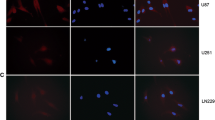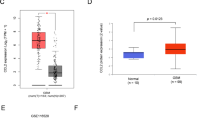Abstract
Macrophages and monocytes migrate in response to chemotactic cytokines such as monocyte chemoattractant protein 1 (MCP-1/CCL2) in a variety of tissues including the central nervous system. Overexpression of MCP-1 has been reported in glioblastoma (GBM), which correlates to prominent macrophage infiltration characterized by this tumor type, but whether MCP-1 receptor is also expressed by the neoplastic cells remains unclear. Expression of MCP-1 and its receptor, CC chemokine receptor 2 (CCR2), were examined in GBM using cDNA microarrays and validated in two independent microarray datasets. We investigated the expression of the CCR2A isoform in human glioma cell lines and GBM, and found overexpression of CCR2A in most GBM specimens examined when compared to normal brain tissues. CCR2A is mainly localized in the cytoplasm of neoplastic cells, and pronounced neuronal cytoplasmic CCR2A immunoreactivity in tumor-infiltrating area was associated with prior chemo/radiation therapy. Glioma cells ectopically overexpressing CCR2A demonstrated increased migration compared to vector-transfected cells in vitro. Inhibition of MCP-1 synthesis suppressed migration of CCR2A-overexpressed glioma cells. Our data suggest that CCR2A might be associated with the pathobiology of GBM such as host response to treatment and tumor cell migration.




Similar content being viewed by others
References
Prados MD, Levin V (2000) Biology and treatment of malignant glioma. Semin Oncol 27(3 Suppl 6):1–10
Nagane M, Huang HJ, Cavenee WK (1997) Advances in the molecular genetics of gliomas. Curr Opin Oncol 9(3):215–222
Liang Y, Diehn M, Watson N et al (2005) Gene expression profiling reveals clinically distinct subtypes of glioblastoma multiforme. Proc Natl Acad Sci U S A 102(16):5814–5819
Che X, Ye W, Panga L, Wu DC, Yang GY (2001) Monocyte chemoattractant protein-1 expressed in neurons and astrocytes during focal ischemia in mice. Brain Res 902(2):171–177
Little AR, Benkovic SA, Miller DB, O’Callaghan JP (2002) Chemically induced neuronal damage and gliosis: enhanced expression of the proinflammatory chemokine, monocyte chemoattractant protein (MCP)-1, without a corresponding increase in proinflammatory cytokines(1). Neuroscience 115(1):307–320
Desbaillets I, Tada M, de Tribolet N et al (1994) Human astrocytomas and glioblastomas express monocyte chemoattractant protein-1 (MCP-1) in vivo and in vitro. Int J Cancer 58(2):240–247
Leung SY, Wong MP, Chung LP, Chan AS, Yuen ST (1997) Monocyte chemoattractant protein-1 expression and macrophage infiltration in gliomas. Acta Neuropathol (Berl) 93(5):518–527
Platten M, Kretz A, Naumann U et al (2003) Monocyte chemoattractant protein-1 increases microglial infiltration and aggressiveness of gliomas. Ann Neurol 54(3):388–392
Frei K, Siepl C, Groscurth P et al (1987) Antigen presentation and tumor cytotoxicity by interferon-gamma-treated microglial cells. Eur J Immunol 17(9):1271–1278
Monteclaro FS, Charo IF (1996) The amino-terminal extracellular domain of the MCP-1 receptor, but not the RANTES/MIP-1alpha receptor, confers chemokine selectivity. Evidence for a two-step mechanism for MCP-1 receptor activation. J Biol Chem 271(32):19084–19092
Lu B, Rutledge BJ, Gu L et al (1998) Abnormalities in monocyte recruitment and cytokine expression in monocyte chemoattractant protein 1-deficient mice. J Exp Med 187(4):601–608
Boring L, Gosling J, Chensue SW et al (1997) Impaired monocyte migration and reduced type 1 (Th1) cytokine responses in C-C chemokine receptor 2 knockout mice. J Clin Invest 100(10):2552–2561
Kurihara T, Warr G, Loy J, Bravo R (1997) Defects in macrophage recruitment and host defense in mice lacking the CCR2 chemokine receptor. J Exp Med 186(10):1757–1762
Kuziel WA, Morgan SJ, Dawson TC et al (1997) Severe reduction in leukocyte adhesion and monocyte extravasation in mice deficient in CC chemokine receptor 2. Proc Natl Acad Sci U S A 94(22):12053–12058
Peters W, Charo IF (2001) Involvement of chemokine receptor 2 and its ligand, monocyte chemoattractant protein-1, in the development of atherosclerosis: lessons from knockout mice. Curr Opin Lipidol 12(2):175–180
Charo IF, Myers SJ, Herman A et al (1994) Molecular cloning and functional expression of two monocyte chemoattractant protein 1 receptors reveals alternative splicing of the carboxyl-terminal tails. Proc Natl Acad Sci U S A 91(7):2752–2756
Bartoli C, Civatte M, Pellissier JF, Figarella-Branger D (2001) CCR2A and CCR2B, the two isoforms of the monocyte chemoattractant protein-1 receptor are up-regulated and expressed by different cell subsets in idiopathic inflammatory myopathies. Acta Neuropathol (Berl) 102(4):385–392
Tanaka S, Green SR, Quehenberger O (2002) Differential expression of the isoforms for the monocyte chemoattractant protein-1 receptor, CCR2, in monocytes. Biochem Biophys Res Commun 290(1):73–80
Sanders SK, Crean SM, Boxer PA et al (2000) Functional differences between monocyte chemotactic protein-1 receptor A and monocyte chemotactic protein-1 receptor B expressed in a Jurkat T cell. J Immunol 165(9):4877–4883
Tran PB, Miller RJ (2003) Chemokine receptors: signposts to brain development and disease. Nat Rev Neurosci 4(6):444–455
Andjelkovic AV, Song L, Dzenko KA, Cong H, Pachter JS (2002) Functional expression of CCR2 by human fetal astrocytes. J Neurosci Res 70(2):219–231
Banisadr G, Queraud-Lesaux F, Boutterin MC et al (2002) Distribution, cellular localization and functional role of CCR2 chemokine receptors in adult rat brain. J Neurochem 81(2):257–269
Stanimirovic D, Satoh K (2000) Inflammatory mediators of cerebral endothelium: a role in ischemic brain inflammation. Brain Pathol 10(1):113–126
Sonoda Y, Ozawa T, Hirose Y et al (2001) Formation of intracranial tumors by genetically modified human astrocytes defines four pathways critical in the development of human anaplastic astrocytoma. Cancer Res 61(13):4956–4960
Liang Y, Haring M, Roughley PJ, Margolis RK, Margolis RU (1997) Glypican and biglycan in the nuclei of neurons and glioma cells: presence of functional nuclear localization signals and dynamic changes in glypican during the cell cycle. J Cell Biol 139(4):851–864
Maus UA, Herold S, Schlingensiepen KH et al (2000) Antisense oligomers for selective suppression of MCP-1 synthesis in human pulmonary endothelial cells. Antisense Nucleic Acid Drug Dev 10(3):185–193
Sun L, Hui AM, Su Q et al (2006) Neuronal and glioma-derived stem cell factor induces angiogenesis within the brain. Cancer Cell 9(4):287–300
Bredel M, Bredel C, Juric D et al (2005) Functional network analysis reveals extended gliomagenesis pathway maps and three novel MYC-interacting genes in human gliomas. Cancer Res 65(19):8679–8689
Schwamborn J, Lindecke A, Elvers M et al (2003) Microarray analysis of tumor necrosis factor alpha induced gene expression in U373 human glioblastoma cells. BMC Genomics 4(1):46
Conti I, Rollins BJ (2004) CCL2 (monocyte chemoattractant protein-1) and cancer. Semin Cancer Biol 14(3):149–154
Barbero S, Bonavia R, Bajetto A et al (2003) Stromal cell-derived factor 1alpha stimulates human glioblastoma cell growth through the activation of both extracellular signal-regulated kinases 1/2 and Akt. Cancer Res 63(8):1969–1974
Khodarev NN, Labay E, Darga T et al (2004) Endothelial cells co-cultured with wild-type and dominant/negative p53-transfected glioblastoma cells exhibit differential sensitivity to radiation-induced apoptosis. Int J Cancer 109(2):214–219
Huang R, Lin Y, Wang CC et al (2002) Connexin 43 suppresses human glioblastoma cell growth by down-regulation of monocyte chemotactic protein 1, as discovered using protein array technology. Cancer Res 62(10):2806–2812
Acknowledgements
We thank the Neurosurgery Tissue Bank at the University of California, San Francisco for contributing tissue specimens in this study. We are grateful to Sharon Reynolds for commenting on the manuscript. Funding support was provided by the Department of Neurosurgery at UCSF. UCSF is an NCI-designated Specialized Program of Research Excellence for Brain Tumors.
Author information
Authors and Affiliations
Corresponding author
Rights and permissions
About this article
Cite this article
Liang, Y., Bollen, A.W. & Gupta, N. CC chemokine receptor-2A is frequently overexpressed in glioblastoma. J Neurooncol 86, 153–163 (2008). https://doi.org/10.1007/s11060-007-9463-7
Received:
Accepted:
Published:
Issue Date:
DOI: https://doi.org/10.1007/s11060-007-9463-7




